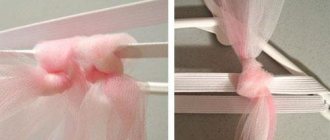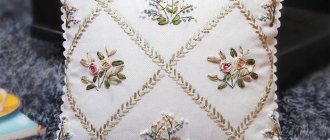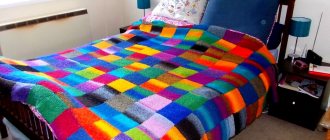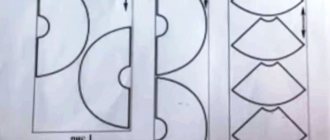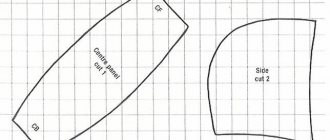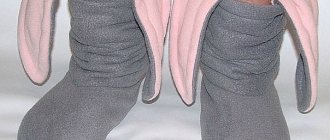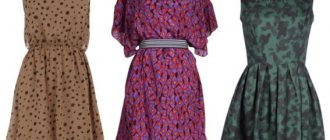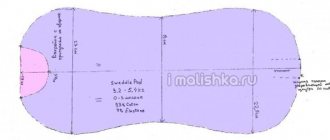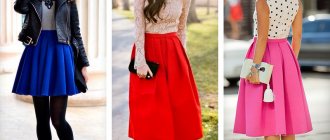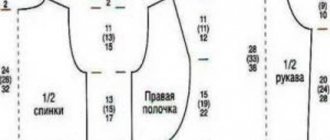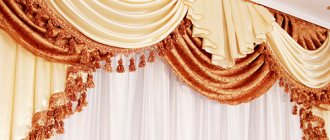Garden furniture is used in difficult conditions, so it is made durable, reliable and easy to use. As a rule, such furniture is equipped with removable soft pillows, which, if necessary, can be brought into the house during rain or winter, washed or dry cleaned. We tell you what to look for when choosing pillows for furniture for your dacha, so that they last a long time and provide you with maximum comfort. We’ll also look at how to make cushions for garden furniture with your own hands.
Materials for cushions for garden furniture
Even the most durable types of cushions for garden furniture are susceptible to external factors. Materials for outdoor textiles are selected based on their resistance to action:
- high and low temperatures;
- atmospheric humidity and precipitation;
- bright sunlight;
- sea spray.
Outdoor pillows are made using durable and attractive materials. After all, textiles should not stand out from the general style of the garden, yard or plot. They make the furniture even more beautiful and the rest even more comfortable. Also read about the best pillows for sleeping at the link.
Garden furniture refers to designer chairs, benches, benches, and long benches. Therefore, pillows are used not only for their classic use, but also for seats and mattresses, as a decorative element in gazebos and terraces.
Fabrics
Garden textiles must fulfill their functions. Special fabrics are used to sew country pillows. They are intended for outdoor use. They are subject to the following requirements:
- pillow covers should be easy to clean;
- the fabric should be pleasant to the touch and allow air to pass through well;
- the material must meet all hygienic requirements: not rot, not become moldy, and not give insects a chance to settle in it.
Fabric design is given no less attention. Fabrics should not fade in the sun. It’s good if they retain their original appearance for a long time. In street conditions this is not so easy to achieve. But manufacturers managed to increase the fading resistance of fabrics. For this purpose, persistent dyes are used, which are used to color the fibers at the stage of their formation.
Outdoor fabrics are subjected to special treatment. Dirt-repellent treatment and antibacterial impregnation of fabrics prevent the appearance of dust mites. Water-repellent substances are also applied to the material. Such procedures make the fabric strong and durable.
For pillows used in closed gazebos, less expensive fabrics can be used. They should not be left outside when it rains. But even if this happens, the pillows will dry quickly and will not lose their decorative effect.
For benches, stools, chaise lounges and armchairs, pillows made of upholstery fabric, furniture fabric - microfiber, as well as mixed fabric with special impregnation are suitable. They are easy to care for, especially if the outdoor cushion cover is removable.
Natural materials quickly lose their color in the sun and wear out. They are used much less frequently. For lovers of everything natural, jacquard, as well as other mixed fibers made from cotton and linen compounds, will be suitable. It is better not to use wool for pillows. Reviews of jacquard fabric can be found here.
Fillers
All pillow fillings are divided into two groups:
- artificial.
The best fillings for cushions for garden furniture are artificial. They dry quite quickly, keep their shape well, are washable, plus they do not harbor parasites and mold fungi. Natural fillers can cause allergies, they take longer to dry, and some of them require special care.
The most inexpensive artificial fillers for garden pillows:
- padding polyester;
- sheet foam rubber;
Do you want to hang a roller blind on a plastic window? Read the instructions.
For more durable products use:
- dacron;
- holofiber;
- Kholkon (reviews about Kholkon can be found in this material);
- latex;
- highly elastic polyurethane foam;
- comfort.
Sewing details
The design of garden cushions should include the possibility of washing the covers. This is especially important for stools and garden swings. It is better to choose pillows with removable covers. They can be fastened with a zipper, buttons, Velcro or buttons.
When choosing a pillow for the garden, you need to pay attention to the seams. They should be:
- smooth;
- strong;
- no visible holes.
In quality pillows, the holes in the seams should be barely noticeable. Through large holes, the filler can be knocked out. This will reduce the service life of the product and cause inconvenience during operation.
It is important that manufacturers use good threads, otherwise the seams may come apart, even if the pillows are handled very carefully. Before purchasing, you can check the quality of the seams by lightly pulling them. A good pillow will easily withstand such tests.
Modern manufacturers offer outdoor pillows with welded seams. Such products are very durable, they are tear-resistant and can withstand heavy loads. Typically, this technology is used in the production of cushions for premium garden furniture.
Uncover
The round product has an extremely simple pattern - it is made in the shape of a perfect circle with exactly the same diameter as a rattan chair.
The Papasan wicker chair has a standard diameter of 150 cm. You will need a piece of material 150 by 300 cm for one pillowcase. The size of the decorative pillowcase is selected 1-3 cm larger than the inner cover.
So, if the chair was already sold with a pillow, take it and draw an outline on the fabric.
If you are sewing from scratch, measure the diameter of the seat with a flexible tape, and draw a circle of the desired diameter on the wrong side of the fabric. Use regular chalk, a bar of soap, or a simple pencil and ruler, operating them like a compass.
When cutting, step back a couple of centimeters from the given outline - this will be the seam allowance. Cut two pieces for each pillowcase.
Pillows for garden furniture - DIY sewing and patterning
- Ideas for arranging furniture in a small room
- Is it possible to place a bed opposite the door?
- How to sell furniture active sales?
Pillows for garden furniture are part of the interior of a garden area for relaxation. Garden furniture made from natural material or plastic is durable, comfortable, but tough. You will need pillows for comfort.
It’s hard to imagine a comfortable holiday without garden furniture for eating, relaxing and a rocking chair in which you can quietly read a book
Why are they needed?
You can place decorative pillows on sofas, armchairs, ottomans, in any room, especially a children's room, or a living room. Why do some people decide not to buy ready-made models, but to make them themselves? Firstly, you can create an original version, made with love, only with your hands. Secondly, it is cheaper to remake an old unnecessary thing or create it yourself from scrap materials.
Decorative furniture will be a good gift option for family and friends. The main rule is that they must match the design of the room in which they will be located. Therefore, it’s easy to do this for yourself; when preparing a gift, you must first find out the design of the room for which they will be intended.
Decorative pillows - will help make the interior brighter
Aquarium in the interior of an apartment or house: 145+ (Photo) types for your design (corner, dry, partition, small)
What materials are used
There are many different pillows in supermarkets and online stores:
- for sleeping, comfortable sitting on an armchair, sofa;
- seat cushions placed on stools for softness;
- cushions for garden swings and furniture in different colors and shapes.
Pillows are sewn in the form:
- mattresses for garden swings and wide wicker sofas;
- curved hard bolsters for placing under the back;
- tiny thoughts under your head;
- and even thick blankets.
In order for a garden accessory to last a long time, you need to choose the right fabric.
Exposure to the sun causes the fabric to quickly fade. If there is a swimming pool, fountain or shower on your personal plot, then moisture resistance is also needed.
Fabrics
The fabric must be especially durable. If you have children or pets on holiday in the garden in the summer, you can share space with them on a wooden swing, bench or chair. For strength, it is recommended to stuff the fabric with filler and stitch it. In a separate segment, limited by a line, it will be easier to eliminate damage.
A garden cushion can be cut into any shape and made of any thickness, similar to a cushion for a sofa, or like a pancake for a flat seat
When choosing material for sewing pillows, remember several essential requirements:
- The color you like should dominate the surrounding environment, or create a feeling of harmony if everything is decorated in the same style;
- The fabric must be resistant to fading, otherwise it will quickly take on an unkempt appearance;
- Natural fabrics wear out and shrink very quickly. Synthetic lasts a long time, but it is not pleasant to the skin. You need to choose textiles with the optimal combination of synthetic and natural threads.
- The material should be soft enough to be comfortable to sit on. In this case, the fabric must be dense and resistant to mechanical damage.
An important role in furniture accessories is played by padded fabric, which must also meet strictly specified conditions.
- Adhesive paper for furniture
- How to attach a countertop to a kitchen unit?
- Adhesive edge for furniture
Fillers
Country pillows are usually filled with padding polyester or foam rubber.
It is easy to stuff the finished product with such materials
The cover can be made with a zipper to make it easy to wash. You can stitch it in squares to prevent the inner padding from bunching up. For summer holidays they prefer to sew something different from home decor. The main style of such soft things is practicality and utilitarianism, without any special decorations, embroidery, frills or appliqués.
Therefore, the main means of expression are padding that is resistant to deformation from mechanical stress and fabric of original colors.
Although the abundance of stuffing materials leaves a wide scope for choice, some types can be difficult to stuff when sewing home pillows.
How to sew a pillow with your own hands
The process of making such things is simple. They are usually sewn in a geometric shape, and the size is quite easy to determine by measuring the parameters of the furniture. For a country dining set, several identical pillows are sewn; for a swing bench, you can sew a full-length mattress and several pillows of different sizes. The thrifty housewife economically cuts out from a piece of fabric the required size of the fabric, lays them out inside out and sews three seams on a machine. If it is necessary to insert a zipper, it is sewn in immediately.
We recommend watching the video: how to sew a furniture cover.
Fur seats
Another option to add to the previous ones. Fur seats will fit perfectly into a country house, when even in the cold season you want to sit outside.
Fur seats for a stool or chair can be made in a couple of hours. After all, the fur itself is dense and warm. It is enough to cut the fabric to size and sew the edges.
Both natural and artificial materials are suitable.
Fur seats will last a long time, just remember to store them properly if you put them away in the closet for the summer. Put anti-moth products.
How to sew cushions for garden furniture
Garden furniture is used in difficult conditions, so it is made durable, reliable and easy to use. As a rule, such furniture is equipped with removable soft pillows, which, if necessary, can be brought into the house during rain or winter, washed or dry cleaned. We tell you what to look for when choosing pillows for furniture for your dacha, so that they last a long time and provide you with maximum comfort. We’ll also look at how to make cushions for garden furniture with your own hands.
- Cleaning furniture with a steam cleaner
- How to adjust furniture hinges?
- DIY furniture decor ideas
Mounting options
To prevent a hand-made seat from sliding onto a chair, it must be secured. There are several fixation options.
- For square stools, it is enough to sew 4 small elastic bands at the corners to the pillow.
- The round one is fixed with an elastic band around the perimeter, for which a drawstring is sewn to the product.
- You can attach a seat to a chair with a back if you attach 2 ties in the corners and connect them with a knot under the seat. They are usually made from the same material as the fabric of the cover.
- The simplest method of fixation is fastening using ordinary Velcro, which is attached to the edges of the pillow.
All fastening options are selected taking into account the type of finished product.
Basic requirements for cushions for garden furniture
Almost all the same requirements apply to cushions for country furniture as to the furniture itself:
Resistance to sunlight - should not fade in the sun.
Easy to clean from dirt and dust, moisture resistance and protection from insects, mildew and mold.
High density of filler - must withstand significant weight loads and not deform.
No small decor (buttons, lace or braid) that could interfere with comfortable sitting.
Pillows for country furniture must have removable covers.
Resistant to mechanical damage and non-slippery fabric of the covers.
And lastly, garden pillows must “breathe”.
How to attach the seat
There are several ways to attach it so that the seat stays tightly and does not move out. Choose the option that suits you best.
- To the back of the chair. Or from behind, hugging it all (this is how they decorate it at weddings). Or on both sides, if there are rods.
- Bottom of the seat: with ties, Velcro, button (when the two ends of the ties are tightly fastened).
- No fastening. Suitable for fur covers or seats made of thick fabric and foam rubber. The pillow is simply placed on a hard surface.
- For the legs. On four sides.
- The seat is placed on a piece of furniture (on a stool or chair). In this case, its size should be several centimeters smaller than the seat and should stretch.
Case material
Covers are one of the most important parts of outdoor furniture cushions. Ease of maintenance and durability depend on their choice. You will be in constant contact with this part of the pillow, which means it should be easy to clean and pleasant to the touch. Insects, fungi and mold should avoid such a pillow!
This is why they came up with special fabrics for outdoor use.
. As a rule, these are synthetic materials - polyester, polyacrylic and polypropylene labeled “outdoors”. Such fabrics are treated with a special insect repellent compound and covered with dirt-repellent and water-repellent layers. To prevent pillows from fading in direct sunlight, they use permanent dyes. At the same time, fabric fibers are dyed at the formation stage. This makes the material durable and easy to use, and also helps it maintain an attractive appearance for a long time.
If you want to purchase or sew a pillow for indoor spaces
, for example, verandas or terraces, then you can choose less expensive fabrics. However, they must contain so-called “mixed fibers”, i.e. synthetic fibers must be mixed with natural ones. The ideal proportion is 50x50. An example of such a fabric is furniture microfiber. However, remember that in this case the pillows will not be resistant to moisture, which means they cannot be left in the rain.
Unfortunately, natural fabrics
When used outdoors they lose color very quickly. Therefore, they are not recommended for use in garden cushions. The exception may be jacquard or mixed fabrics made of cotton and linen with an admixture of synthetic fibers. Also exclude:
leather and its synthetic substitutes
— it’s very hot to sit in the sun;
silk
- deforms almost immediately;
wool, fur and long pile fabrics
— they cannot be cleaned well.
Preparing parts for the bench frame.
To make the frame, a 40x30mm block and a 40x20mm rail were used, and the dimensions of the frame were 950mm in length, 255mm in width and 420mm in height.
The frame of the bench is assembled from eleven parts, eight of which carry the power load and are made of 40x30mm timber:
two horizontal side rails 870 mm long; two horizontal cross bars 195 mm long; four legs 420mm long.
For beauty and at the same time to strengthen the structure, we took a 40x20mm rail, which was used to connect the legs of the bench in the lower part with three parts:
one horizontal side rail 870mm long; two cross bars 195 mm long.
If you cut the frame parts with a hacksaw, then to obtain a straight end cut, lines are marked on both sides of the block, along which cuts about 5 mm deep are made with a hacksaw. The result is guide tracks from which the hacksaw will not move to the side during sawing and the end of the block will be even.
When you cut off the part, start sawing from the near upper corner so that the hacksaw blade simultaneously runs along the vertical and horizontal guide tracks.
When all the frame parts are cut off, the next step is to sand them well to get rid of dirt, irregularities, scratches and burrs. The wooden surface must be clean, level and smooth. And when it is like this, the stain and varnish will lay well on the surface, and the bench will look no worse than the factory one.
The wood is first sanded with coarse sandpaper, and then fine sanded to a smooth state. For these purposes, there is a special grater, on the working surface of which a piece of sandpaper is attached. If you don’t have a grater, then use a small block wrapped in one layer of sandpaper.
It is advisable to perform this stage of wood processing outdoors or in some technical room, as there will be a lot of fine dust. Although the process itself is not so creative, it must be taken seriously.
When the parts are ready, we begin assembling the bench frame. In the store bench, all the frame elements were connected by coupling screws, so I didn’t invent anything and did the same. I only needed fourteen of these screws.
Advice
. It is not always possible to smoothly process the surface of the wood; one of the sides will definitely have a knot or some kind of flaw. Therefore, when making a frame, try to hide the surface with the flaw inside or install it in a less noticeable edge.
Pillow filler
The second important element in garden pillows is filler.
. It determines how comfortable it will be for you to sit on the furniture and how long the pillows will last. After all, fabric covers can be easily replaced, but changing the filling is equivalent to buying new pillows. Therefore, the filler must be durable, and for this it should not deform under the weight of guests sitting on it, change with temperature changes, or swell due to humidity.
There are two types of pillow fillings - natural and artificial. synthetic fillers are more convenient and durable
, especially when it comes to garden furniture. Such pillows dry quickly and get rid of moisture on their own, are not susceptible to mold and mildew, insects do not like them and can be washed in a machine.
It is also important to determine how you will use the pillow
- as a seat, in place of the backrest (lumbar) or for decorative purposes. If you are going to sit on a pillow, you need materials that are durable, hold their shape, and are resistant to deformation. For example, latex, polyurethane foam, Holcon or foam rubber. The latter is less durable, but much cheaper. Popular artificial fillers for decorative pillows are polystyrene balls (the kind used in soft toys), padding polyester and holofiber.
Sofa pillows in the interior
The classic interiors of modern living rooms and bedrooms will be stylishly complemented by square and rectangular sofa cushions, as well as cushion cushions with original decor.
In terms of patterns and colors, they do not necessarily have to match the upholstery of furniture or curtains. Non-trivial interior solutions and eclecticism (a thoughtful combination of several styles) are in fashion.
For example, sofas can be decorated with many (designers advise choosing an odd number) bright decorative pillows that differ, and even contrast, in colors and textures. They do not violate the harmony at all - on the contrary, they look stylish and interesting. You can arrange multi-colored pillows in one row, in tiers or in groups. Such a colorful composition will look especially good on long, corner and modular sofas.
In high-tech and loft settings, combinations of several sofa cushions that differ in shape will look stylish. For example, oval, triangular and rectangular on one sofa or chair. It’s good if prints or other decorations “echo” each other in shades or thematically. To prevent sofa cushions from looking like a foreign detail in restrained avant-garde interiors, it is better to choose an interesting but laconic decor.
The trend in interior fashion includes decorative pillows with abstract and geometric patterns, with inscriptions, with appliqués, as well as plain ones. You can safely combine different types of prints in one composition. For example, small and large ornaments, a checkered pattern with stripes or polka dots, floral motifs with abstract patterns. However, in order for the overall interior to look stylish, the individual decorative details of the sofa cushions must still be in harmony with each other.
A good solution for vintage and oriental interiors would be unusually shaped sofa cushions. For example, “tablet” pillows, polyhedrons, cushions with elegant and romantic decor: tapestries, rich embroidery, hemstitching, tassels, fringe, lace trim, spectacular draperies.
Beautiful sofa cushions of non-traditional shapes are suitable for a child's room: ball pillows, knot pillows, toy pillows made of bright textiles, artificial velor, fur of a wide variety of rich and cheerful colors. By design, they can complement the main theme of arranging a nursery or become an interesting contrasting accent in the interior.
Shape and design
As a rule, square or rectangular pillows
to suit the size of the seat or backrest. The most popular sizes of square garden pillows are from 35 to 50 cm, rectangular - 60x30 cm, 62x42 cm and 62x37 cm. The best thickness for lumbar pillows is 5-8 cm, and for sitting sofas, benches and armchairs - 6-12 cm. In addition, round pillows are sewn for stools, poufs and banquettes, and trapezoidal patterns are made for chairs and garden furniture of non-standard shape.
Decorative pillows for country furniture
can be of any shape, size and thickness. However, when sewing them, also use all the rules for garden pillows. Choose dense and durable, well-dyed fabric and durable synthetic filling. Despite the fact that you will not sit on such pillows, they will still be subject to the same harsh environmental influences.
Pouf seat
For such a seat you will need about 1000 kilograms of medium thickness yarn.
Crochet according to the pattern until you get a circle with a diameter of 40 cm. Continue knitting without increments for 52 cm and cut the thread. Diameter: 40 cm, height - 50 cm.
What should you not do when sewing pillows for country furniture?
Use natural fabrics and natural fillers - some fade instantly, others take on a new life (fungi, mold, bugs).
If you combine several different fillings in one product, such a pillow will quickly lose its shape.
Filling a pillow with old filling (cotton wool, fur coats, mattress fillings) will lead to lumps and lumps in the pillow.
When sewing, use thin or poor quality threads - such a pillow will very quickly collapse at the seams.
Seat cushion with embroidery
A great idea for true aesthetes! Don’t just sew a seat, but decorate it with a landscape, a bouquet of flowers or gardening motifs.
For these purposes, use canvas or a special fabric on which you can cross-stitch. Embroider the central part of the seat according to the patterns below, and the bottom from thick fabric to match.
This pillow can be used as a decorative one, or for its intended purpose - on a chair, stool, etc.
Unusual country furniture with your own hands: we use fabrics. Floor cushions
Wood has always been considered a traditional material for making furniture in many countries. True, today wooden cabinets or tables threaten to become rare and unusual furniture: wood is being successfully replaced by a variety of chipboards, MDF, and composite materials. Furniture is also made from metal, plastic, glass - regular and organic, and acrylic. And also made of fabric.
Furniture made from fabric Textiles are inseparable from the interior of a home: even the most brutal or technologically advanced living space cannot do without things made from fabric or its analogues. Curtains, tablecloths and bedspreads, pillows, carpets, furniture covers and upholstery - textiles are equally involved in creating the style of a home. But this article is about fabric, which is used not as an addition, but as a full-fledged part of the furniture structure.
For some, textile furniture is not something unusual: armchairs and sofas that do not have rigid frames, screens and poufs in such interiors make up a complete home or even office setting. The well-known oriental (or Arabic) style, which many associate with the fairy tales of Scheherazade, is largely based on the widespread use of all kinds of pillows for sitting and lying on the floor or low ottomans.
Today, fabric furniture is becoming a popular element in familiar European interiors. For example, the Italian company, which has been engaged in home textiles for more than a hundred years, has identified a separate direction “MissoniHome”, whose designers create full-fledged pieces of furniture from textiles.
Interior by MissoniHome. Photo from missonihome.com
Many furnishings made from fabric, leather, felt, felt, and modern non-woven materials are quite accessible to create with your own hands, especially if you have sewing or knitting skills. This is the option I want to consider in more detail.
And the set includes covers for chair legs
If you have already decided to make chair seats with your own hands, then here’s another idea for you: covers for chair legs. This is both functional (floors are not scratched, and chairs can move silently) and unusual. They can be sewn or knitted, depending on what the seats themselves will be like.
The easiest way to crochet them is to take no more than an hour. And an ordinary chair will turn into something designer.
A thousand and one pillows
Our mothers always forbade reading while lying down, but, honestly, who follows their mother’s wise instructions one hundred percent? We love to read while lying down, watch TV, and now also work: after all, laptops were invented for this very purpose, so as not to be tied to a classic workplace.
Many people like to just sit on the floor, even if there are quite decent sofas and armchairs. And for children, soft, cozy pillows or mattresses are both a place and a means of play.
Cozy pillows - comfortable not only indoors
If you welcome this informal style, do not deny yourself the pleasure of lying on the floor, and with soft support it is much more comfortable.
Floor cushions are a good way to accommodate many guests: there is no need to clutter the living room with an abundance of armchairs or occupy the chairs of neighbors. And if the visitors are late, then the mats and pillows will also become an additional sleeping place.
This method of decorating a living room is ideal for a dacha: we go out of town to take a break from the city officialdom, and floor cushions for sitting or lying perfectly contribute to this, creating a relaxed atmosphere. Soft seats do not take up much space, they can be compactly removed if they are not needed, and used not only indoors, but also on the lawn if the weather is pleasant.
Another option from MissoniHome. Photo from missonihome.com
They can also become an interior decoration, its highlight, and also a way to easily change the decor: just change the covers.
It is possible to buy various options for such simple “upholstered furniture” - different shapes, thicknesses, sizes, colors and materials. But you can sew it yourself; all kinds of fabrics and modern fillers are now on sale.
For inspiration, I offer a few photos of designers’ ideas on this topic. Floor pillows, mats, poufs, pillows for lying down, giant pillows, modular, anatomical, beanbags - there are a variety of options for such upholstered furniture on sale. I’ll try to create some kind of classifier for the pillow manifold.
Pillow like pillow
This is the simplest type of furniture cushions: it has a traditional rectangular, square or round shape, in which length and width prevail over height. Can be either standard size or XXXL. Larger specimens are used in different ways. For example, like this:
Large floor cushion
If you equip a large pillow with straps or ties, then after simple manipulations you can get a pillow-chair. The fixed shape facilitates the process of sitting down and standing up.
We choose materials for floor pillows and finishing methods according to our taste, as well as manufacturing techniques. Patchwork, embroidery, lace, macrame, with beading, stitching, tassels and pom-poms: floor models are an inexhaustible field for creativity.
Take your pick Those who are familiar with felting techniques can try their hand at creating soft stone. These felt pillows-stones were invented by designer Stephanie Marin. Large and small, gray and colorful, resembling giant pebbles. If you have never tried making felt products, maybe creating such a pillow is a good reason to start?
Soft stones by Stephanie Marin. Photo from smarin.net Don't like felt? Try making knitted floor pillows. Such poufs with knitted covers will require very thick yarn and structural knitting. However, this is not at all necessary: knit with ordinary threads in any pattern you like - it will turn out no worse.
Knitted pouf in the interior
Or just use ready-made knitwear, for example, sew a pillow from old children's sweaters. Children grow up quickly, and things don’t have time to wear out.
If children have grown out of sweaters and jackets, make pillows from unnecessary things. Photo from blog.naver.com
There are a great many options for floor pillows: you can choose according to your taste, mood or room decor style. In the following publications I will continue to review furniture made from pillows: beanbags and poufs, modular frameless furniture and futons.
How to choose a toolkit?
In addition to the direct elements and materials that will make up the finished product, it is very important to correctly select all the tools. With its help all work will be carried out
First of all, special attention should be paid to the threads
They must match not only the color scheme of the pillow, but also ideally match the density of the selected fabric. Silk, chintz or cambric require threads no denser than No. 80; calico or flannel fabrics are well secured with No. 60 or 50, but raincoat or denim fabric should be sewn exclusively with No. 40 threads.
You can do this kind of handicraft not only with a sewing machine, but also without it. It will just take a little longer, but the finished result and quality will not suffer. In addition to a set of needles for manual or automatic work, you will also need:
- large sharp scissors;
- cardboard and paper for patterns;
- soap, sewing crayons or pencils for cutting and marking fabric;
- hoops, floss, special threads or knitting needles, if embroidery or knitted elements are intended;
- meter tape or large ruler;
- pins.
Pillows for garden furniture: selection of products, self-production and where you can buy ready-made ones
Cushions for garden furniture are made from padding polyester and other materials coated with acrylic and polyester fabric. At the same time, there are different colors, shapes and sizes of products. The possibility of producing design solutions is also provided.
Outdoor furniture cushions
If you need a cushion for Risa garden furniture, you can choose plain and colored products using foam rubber or polyester wadding to create quilted and printed products. The dimensions of the furniture elements require placement on armchairs, chaise lounges, swings and banquettes.
Materials and equipment
Mattresses and pillows for garden furniture can be manufactured independently using the following elements:
- Sewing machine
- Needles and threads
- Textiles
- Finishes
- Fillings
- Pins
- Scissors
sew cushions for garden furniture
using step-by-step instructions:
Manufacturing stages: Preparation of matter
An old tablecloth, shirt, or remnants of roofing materials can be used as material. 2 square products with equal parameters are cut out. The selection of parameters is carried out individually.
Attention!
You can cut out a round and triangular shape, a product in the shape of a star or any other object.
Decorative elements
Sewing pillows on garden furniture as decorations involves the use of fringe, tassels and lace elements. The sides of the pillow are measured to determine the required trim length. You can make a reserve of 7-8 cm. The trim is attached along the edges of the soft element.
Upholstered elements for country furniture
Preparation of the structure
- It is necessary to decide on the location of the back side. Place the pieces right sides together. Spread the cloth on the table. Fold down the top edge.
- The trim is laid along the bottom edge of the soft element. Leave close to 1 cm of braid on the outside. The upper part of the fabric is returned to its place. Using pins, pin all layers of pillows at the corners.
- After all the parts are smooth, you need to pin them with pins at a distance of 5 cm from all corners. The pins are placed along the edge. Step of 25 mm.
- When you reach the next corner, you need to turn the fabric with the other side towards you. Bend 3-5 cm at the top. Place the finishing element in the corner. In this case, the trim folds into a fold.
- When choosing a pillow made in a square or rectangular design, the product is folded at a right angle.
- The fabric is pinned at the corner using pins. The trim is placed along the edge of the next part. The upper part is placed in the same place. The corner is chipped. A pin is placed 5 cm from the corner. They are then distributed along the edge on the next side.
- When finishing all sides, part of the pillow remains unchipped. This involves placing filler.
Pillow for a country house set
Applying a seam
When using machine stitching, a zigzag stitch is used. After removing all the pins, the pillow is turned inside out and filled with soft material.
Work algorithm
Before making the seat, you need to take measurements. This can be done using a tape measure. After measurements, a pattern of all elements is made. For individual pillows and solid covers, the principle of this process is the same. The pattern starts with the seat. Taking into account the measurements taken, a figure is drawn on the newspaper that repeats its shape.
Add 1.5-2 cm to seam allowances on all sides.
Next comes preparation for cutting. This will require the material that is used for the top of the case. If the composition contains more than 50% natural fibers or the weave of the fabric is loose, there is a high risk of shrinkage. Therefore, wet and heat treatment of the fabric is necessary before sewing, this is how natural shrinkage occurs. The material is well moistened, dried, and ironed.
Patterns of chair cushions are laid on the prepared fabric. It is necessary to take into account the direction of the shared threads. The elements should be located along the fibers. The patterns are secured with pins and traced with a pencil; the main thing is not to forget about the allowances if the patterns are drawn without them. All elements are carefully cut out, and then sewing of the product begins.
Regardless of the shape, the process of making chair cushions with your own hands is the same.
Step-by-step instructions for making a separate structure.
- Sewing the seat. The lining and base are folded facing inward. The material is leveled and swept away. After the machine stitching is done, the back of the seat should remain unsewn, a zipper is attached to it. Next, the cover is turned inside out and carefully straightened. Afterwards they are filled with the selected filler.
- Sewing the back. The main fabric and lining are folded face to face, ties are inserted between these materials and basted to the main part. The fasteners should be on the sides of the backrest. The stitching is done by machine, only the lower part remains unsewn, through which the cover is turned inside out.
- At the end the decor is attached.
A fabric pillow for a round stool is made in the same way. Sewing master class:
- choose fabric;
- measure the diameter of the seat for the pattern;
- an elastic band is sewn to the seat, it is applied to the edge of the fabric on the inside;
- while sewing, you need to hold the elastic band and turn the product evenly in a circle;
- foam rubber or synthetic padding is placed in the finished cover, and at the end the pillow is attached to a stool.
The product is decorated at the discretion of the owner. Appliques, lace, braid framing, and embroidery are suitable for the kitchen.
